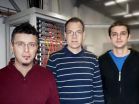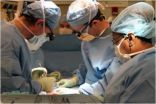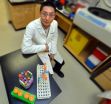(Press-News.org) This press release is available in German.
System-wide networks of proteins are indispensable for organisms. Function and evolution of these networks are among the most fascinating research questions in biology. Bioinformatician Thomas Rattei, University of Vienna, and physicist Hernan Makse, City University New York (CUNY), have reconstructed ancestral protein networks. The results are of high interest not only for evolutionary research but also for the interpretation of genome sequence data. Recently, the researchers published their paper in the renowned journal PLOS ONE.
The cells of all organisms consist mostly of proteins, which develop various functions through their complex interactions. These functions range from metabolism, maintenance and control of the cellular structure to the exchange of signals with other cells and the environment. Proteins rarely act alone – only their system-wide network makes organisms viable. "The knowledge about function and evolution of these protein networks is currently one of the most fascinating questions in biology and relevant e.g. also to cancer research", explains Thomas Rattei, Head of the Department of Computational Systems Biology at the University Center Althanstrasse.
In pursuit of the blueprint of protein networks
The combination of 20 different building blocks – amino acids – results in an enormous variety of theoretically possible protein variants; many more than the estimated number of stars in the universe. The random formation of an interaction between proteins seems therefore extremely unlikely. Thomas Rattei, Professor of In-Silico Genomics at the University of Vienna, and Hernan Makse, Professor of Physics at the City University New York (CUNY), and their teams investigate how complex and manifold protein networks could still evolve in present-day organisms.
Starting point of the joint research project was a hypothesis emphasising the importance of the duplication of proteins in the course of evolution. If the gene encoding a protein is duplicated in the genome, which often happens in evolution, original and copy will interact with the same partners in the protein network. Once original and copy diverge over time, novel proteins with individual features and own partners in the network will emerge. Interactions in the network would thereby not be newly created but evolve through duplication and divergence from simpler ancestors.
Protein networks of extinct ancestors were reconstructed
The two workgroups around bioinformatician Thomas Rattei and physicist Hernan Makse tested and improved this hypothesis in an elaborate computational experiment. They developed a novel method for the reconstruction of protein networks of extinct evolutionary ancestors from the genomes and networks of present-day species. Data of seven species from various domains of life were used: from bacteria, fungi, plants, animals to humans.
Present-day networks – complex structures through simple mechanisms
The comparison of these reconstructed ancient protein networks yielded a surprisingly clear result: the present-day networks can be explained almost exclusively through the mechanism of duplication and divergence. Novel interactions between proteins emerge on rare occasions. This principle seems to be universal in the evolution of species as it was confirmed by the data obtained from all species analysed in this study. This principle could also explain the dynamics of other biological networks and it explains special features of protein networks such as self-similarity (fractality) in a straightforward way.
Useful for the interpretation of genome sequences and evolutionary biology
The results of the joint research project of the University of Vienna and CUNY will not only be relevant for evolutionary biology. They particularly support the interpretation of genome sequence data, which has become a powerful tool in many areas of biology and medicine in the last years. This is also the goal of many other current research projects of the Department of Computational Systems Biology, which focuses on research on pathogens, microbial communities and molecular interactions between species adopting a system-oriented approach.
INFORMATION:
Publication in PLOS ONE:
The evolutionary dynamics of protein-protein interaction networks inferred from the reconstruction of ancient networks. Yuliang Jin, Dmitrij Turaev, Thomas Weinmaier, Thomas Rattei, Hernan Makse. In: PLOS ONE, 2013.
DOI: http://dx.plos.org/10.1371/journal.pone.0058134
Novel insights into the evolution of protein networks
2013-03-21
ELSE PRESS RELEASES FROM THIS DATE:
Planck challenges our understanding of the Universe
2013-03-21
Planck refines our knowledge of the Universe's composition and evolution
New maps provide excellent evidence for our standard model of cosmology
Planck dates Universe at 13.82 billion years old
Anomalies suggest that Universe may be different on scales larger than those we can directly observe
Most accurate values yet for the ingredients of the Universe, with normal matter contributing just 4.9% of the mass/energy density of the Universe and dark matter making up 26.8% - nearly a fifth more than the previous estimate.
Europe's Planck satellite - a flagship mission ...
What you eat before surgery may affect your recovery
2013-03-21
BOSTON, MA—According to a new study, the last few meals before surgery might make a difference in recovery after surgery. Fat tissue is one of the most dominant components that make up the body, and fat tissue is always traumatized during major surgery.
Researchers at Brigham and Women's Hospital (BWH) found that this direct trauma greatly impacts the chemical balance of fat tissue—chemicals that are known to communicate with nearby and distant organs. In the study, mice that consumed a typical Western, high-fat diet showed an exaggerated imbalanced response. Importantly, ...
Researchers tackle physician challenge of correctly ordering laboratory tests
2013-03-21
(Boston) – A new study involving researchers from the Boston University School of Medicine (BUSM) has identified barriers that clinicians face in correctly ordering appropriate laboratory tests and highlights some solutions that may simplify this process and improve patient outcomes. The study, published in the March 2013 issue of the Journal of General Internal Medicine, was led by Elissa Passiment, EdM, of the American Society for Clinical Laboratory Science and James L. Meisel, MD, associate professor of medicine at BUSM.
Passiment, Meisel and colleagues identified ...
Global nitrogen availability consistent for past 500 years, linked to carbon levels
2013-03-21
MANHATTAN -- A Kansas State University research team has found that despite humans increasing nitrogen production through industrialization, nitrogen availability in many ecosystems has remained steady for the past 500 years. Their work appears in the journal Nature.
"People have been really interested in nitrogen in current times because it's a major pollutant," said Kendra McLauchlan, assistant professor of geography and director of the university's Paleoenvironmental Laboratory. "Humans are producing a lot more nitrogen than in the past for use as crop fertilizer, ...
'Gene Therapy for Human Disease: Clinical Advances and Challenges'
2013-03-21
Philadelphia, PA, March 21, 2013 – The April issue of Translational Research examines the progress and outlook of gene therapy research, with a specific focus on the clinical applicability of gene therapy today. Research articles included in the special issue highlight current studies that, after decades of trial and error, may provide evidence for a clear path of treatment and cure for many diseases. There are more than 1,800 genetic disorders known in humans, and only a small fraction of these can be treated and even fewer cured. Some of these disorders are exceedingly ...
'Sideline quasars' helped to stifle early galaxy formation, says CU-Boulder study
2013-03-21
University of Colorado Boulder astronomers targeting one of the brightest quasars glowing in the universe some 11 billion years ago say "sideline quasars" likely teamed up with it to heat abundant helium gas billions of years ago, preventing small galaxy formation.
CU-Boulder Professor Michael Shull and Research Associate David Syphers used the Hubble Space Telescope to look at the quasar -- the brilliant core of an active galaxy that acted as a "lighthouse" for the observations -- to better understand the conditions of the early universe. The scientists studied gaseous ...
Reward linked to image is enough to activate brain's visual cortex
2013-03-21
Once rhesus monkeys learn to associate a picture with a reward, the reward by itself becomes enough to alter the activity in the monkeys' visual cortex. This finding was made by neurophysiologists Wim Vanduffel and John Arsenault (KU Leuven and Harvard Medical School) and American colleagues using functional brain scans and was published recently in the leading journal Neuron.
Our visual perception is not determined solely by retinal activity. Other factors also influence the processing of visual signals in the brain. "Selective attention is one such factor," says Professor ...
Do disruptions in brain communication have a role in autism?
2013-03-21
New Rochelle, NY, March 21, 2013—A new study of patterns of brain communication in toddlers with autism shows evidence of aberrant neural communication even at this relatively early stage of brain development. The results are presented in an article in Brain Connectivity, a bimonthly peer-reviewed journal from Mary Ann Liebert, Inc., publishers. The article is available free on the Brain Connectivity website at http://www.liebertpub.com/brain.
A team of researchers from The Netherlands (University Medical Center Utrecht and Utrecht University, Radboud University Nijmegen ...
Cancer drug shortages mean higher costs and greater risk for patients
2013-03-21
A national survey of health professionals showed that drug shortages are taking a heavy toll on cancer patients, forcing treatment changes and delays that for some patients meant worse outcomes, more therapy-related complications and higher costs. St. Jude Children's Research Hospital investigators played an important role in the study.
The survey queried oncology pharmacists and others involved in managing cancer drug shortages for academic medical centers, community hospitals and other cancer treatment facilities nationwide. Of the 243 individuals who completed the ...
Scientists identify gene that is consistently altered in obese individuals
2013-03-21
AUGUSTA, Ga. – Food and environment can chemically alter your gene function and scientists have identified a gene that is consistently altered in obesity.
The gene LY86 was among a group of 100 genes identified as likely contributors to obesity through genome-wide association studies comparing the DNA of thousands of obese and lean individuals, said Dr. Shaoyong Su, genetic epidemiologist at the Medical College of Georgia at Georgia Regents University.
Su looked at progressively larger groups of obese versus lean individuals and found LY86 consistently and highly chemically ...




